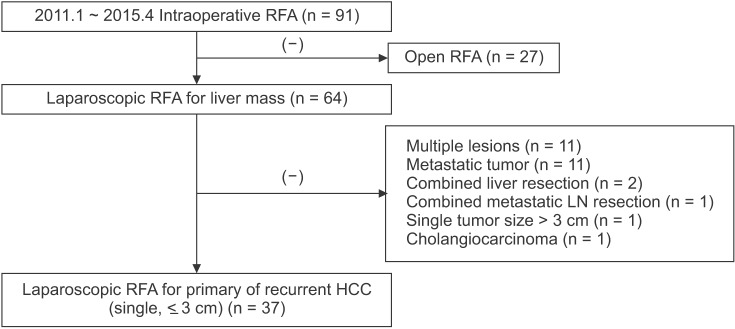Ann Surg Treat Res.
2017 May;92(5):355-360. 10.4174/astr.2017.92.5.355.
Clinical outcomes of laparoscopic radiofrequency ablation of single primary or recurrent hepatocellular carcinoma (≤3 cm)
- Affiliations
-
- 1Department of Surgery, Samsung Medical Center, Sungkyunkwan University School of Medicine, Seoul, Korea. yjongman21@skku.edu
- 2Department of Radiology, Samsung Medical Center, Sungkyunkwan University School of Medicine, Seoul, Korea.
- KMID: 2377706
- DOI: http://doi.org/10.4174/astr.2017.92.5.355
Abstract
- PURPOSE
Percutaneous radiofrequency ablation (RFA) for hepatocellular carcinoma (HCC) has some limitations such as poor sonic window and injury to adjacent organs. The laparoscopic approach has been suggested as an alternative option. The aim of this study was to show the safety and efficacy of laparoscopic RFA for single, small (≤3 cm), and primary or recurrent HCC that is not suitable for percutaneous RFA or surgical resection.
METHODS
We reviewed the cases of 37 patients (32 men and 5 women, mean age 61 ± 8.1 years) who underwent laparoscopic RFA for single, small HCC (≤3 cm) that was unsuitable for percutaneous RFA or surgical resection.
RESULTS
The technical success rate was 94.6% and 34 patients (95%) had no complications. There were no conversions to open RFA and no operative mortality. The primary effectiveness rate 1 month after the procedure was 100%. The overall recurrence rates at 3, 6, 12, and 24 months after the laparoscopic RFA were 8.1%, 14.4%, 25%, and 35.7%, respectively. The local tumor progression rate was 4.2% at 6 months and 8.7% at 9 months.
CONCLUSION
Laparoscopic RFA is a safe and effective treatment for HCC cases that are unsuitable for percutaneous RFA.
MeSH Terms
Figure
Reference
-
1. Yamashita Y, Tsuijita E, Takeishi K, Fujiwara M, Kira S, Mori M, et al. Predictors for microinvasion of small hepatocellular carcinoma ≤ 2 cm. Ann Surg Oncol. 2012; 19:2027–2034. PMID: 22203184.2. Kim JM, Hyuck C, Kwon D, Joh JW, Lee JH, Paik SW, et al. Protein induced by vitamin K antagonist-II (PIVKA-II) is a reliable prognostic factor in small hepatocellular carcinoma. World J Surg. 2013; 37:1371–1378. PMID: 23443153.
Article3. Kang TW, Kim JM, Rhim H, Lee MW, Kim YS, Lim HK, et al. Small hepatocellular carcinoma: radiofrequency ablation versus nonanatomic resection: propensity score analyses of long-term outcomes. Radiology. 2015; 275:908–919. PMID: 25688888.4. Feng K, Yan J, Li X, Xia F, Ma K, Wang S, et al. A randomized controlled trial of radiofrequency ablation and surgical resection in the treatment of small hepatocellular carcinoma. J Hepatol. 2012; 57:794–802. PMID: 22634125.
Article5. Lee SD, Han HS, Cho JY, Yoon YS, Hwang DW, Jung K, et al. Safety and efficacy of laparoscopic radiofrequency ablation for hepatic malignancies. J Korean Surg Soc. 2012; 83:36–42. PMID: 22792532.
Article6. Chen MS, Li JQ, Zheng Y, Guo RP, Liang HH, Zhang YQ, et al. A prospective randomized trial comparing percutaneous local ablative therapy and partial hepatectomy for small hepatocellular carcinoma. Ann Surg. 2006; 243:321–328. PMID: 16495695.
Article7. Kim JM, Kang TW, Kwon CH, Joh JW, Ko JS, Park JB, et al. Single hepatocellular carcinoma ≤ 3 cm in left lateral segment: liver resection or radiofrequency ablation? World J Gastroenterol. 2014; 20:4059–4065. PMID: 24744596.
Article8. Herbold T, Wahba R, Bangard C, Demir M, Drebber U, Stippel DL. The laparoscopic approach for radiofrequency ablation of hepatocellular carcinoma: indication, technique and results. Langenbecks Arch Surg. 2013; 398:47–53. PMID: 23093087.9. Birsen O, Aliyev S, Aksoy E, Taskin HE, Akyuz M, Karabulut K, et al. A critical analysis of postoperative morbidity and mortality after laparoscopic radiofrequency ablation of liver tumors. Ann Surg Oncol. 2014; 21:1834–1840. PMID: 24510186.
Article10. Kong WT, Zhang WW, Qiu YD, Zhou T, Qiu JL, Zhang W, et al. Major complications after radiofrequency ablation for liver tumors: analysis of 255 patients. World J Gastroenterol. 2009; 15:2651–2656. PMID: 19496197.
Article11. Mulier S, Mulier P, Ni Y, Miao Y, Dupas B, Marchal G, et al. Complications of radiofrequency coagulation of liver tumours. Br J Surg. 2002; 89:1206–1222. PMID: 12296886.
Article12. Kasugai H, Osaki Y, Oka H, Kudo M, Seki T. Osaka Liver Cancer Study Group. Severe complications of radiofrequency ablation therapy for hepatocellular carcinoma: an analysis of 3,891 ablations in 2,614 patients. Oncology. 2007; 72(Suppl 1):72–75. PMID: 18087185.
Article13. Yeung YP, Hui J, Yip WC. Delayed colonic perforation after percutaneous radiofrequency ablation of hepatocellular carcinoma. Surg Laparosc Endosc Percutan Tech. 2007; 17:342–344. PMID: 17710065.
Article14. Kang TW, Lee MW, Hye MJ, Song KD, Lim S, Rhim H, et al. Percutaneous radiofrequency ablation of hepatic tumours: factors affecting technical failure of artificial ascites formation using an angiosheath. Clin Radiol. 2014; 69:1249–1258. PMID: 25149600.
Article15. Asahina Y, Nakanishi H, Izumi N. Laparoscopic radiofrequency ablation for hepatocellular carcinoma. Dig Endosc. 2009; 21:67–72. PMID: 19691776.
Article
- Full Text Links
- Actions
-
Cited
- CITED
-
- Close
- Share
- Similar articles
-
- Radiofrequency Thermal Ablation of Hepatocellular Carcinomas
- Microwave thermosphere versus radiofrequency ablation for hepatocellular carcinoma: Are we approaching the time to end the debate?
- Chemoembolization combined with radiofrequency ablation is the best option for the local treatment of early hepatocellular carcinoma?
- Current status and future of radiofrequency ablation for hepatocellular carcinoma
- Radiofrequency Ablation for Hepatocellular Carcinoma



